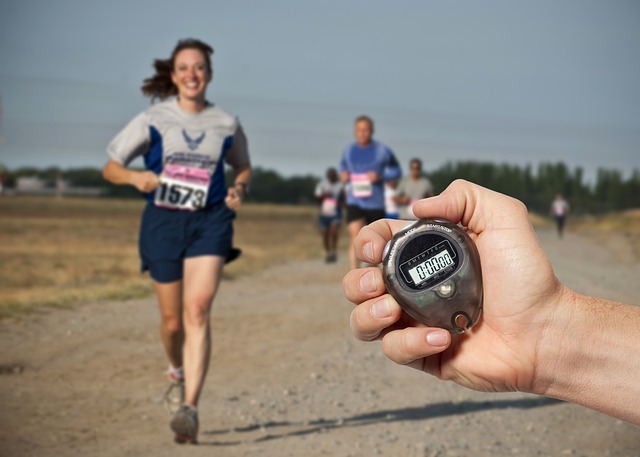
According to running coach and best-selling author Matt Fitzgerald, it is not necessary to be fast in order to run like professional athletes. In fact, top endurance athletes typically devote a majority of their training time to practicing at a comfortable pace. This is a common approach followed by professional athletes in various endurance sports worldwide.
Fitzgerald, who introduced the 80/20 Running method in his 2014 book, stated that the top performers typically engage in approximately 80 percent of their training at low intensity and 20 percent at moderate to high intensity.
According to controlled studies, the 80/20 method has been proven to produce optimal training outcomes for recreational athletes and potentially lower the risk of injuries as well, as stated by Fitzgerald. However, runners tend to primarily engage in moderate intensity training, which can impede progress. This situation, referred to as the “moderate intensity rut,” is comparable to being consistently deprived of sleep, according to Fitzgerald.
He explained that athletes who consistently train slightly above their moderate intensity threshold are continuously burdened with unprocessed fatigue, hindering their ability to adapt.
Take your time.
According to Fitzgerald, adopting the 80/20 rule is the top pro habit to enhance our running. There are various methods to incorporate 80/20 into our routine. Fitzgerald suggests that if we run for 200 minutes each week, approximately 160 minutes should be spent at low intensity, while the remaining time can be divided between moderate and high intensity. Let this serve as a general guideline for your runs.
If you do five runs per week, you have the option of completing three runs at a slow intensity and two runs at a moderate to high intensity, or you can choose to divide each run into 80/20 splits.
The most important thing is that you intentionally maintain a slow pace during your low intensity runs. For instance, you can divide each run into intervals, with 20 minutes of low intensity running followed by 10 minutes of high intensity running.
According to Fitzgerald, if you slow down and stay disciplined during easier sessions, your body will have the opportunity to absorb stress and derive greater benefits from it, even if the changes are not extreme.
To determine if you are running at an excessive speed, one simple method is to acquire a smartwatch that tracks your heart rate. Additionally, you can follow Fitzgerald’s recommendation of the “talk test.” When running at a relaxed pace, you should be able to converse effortlessly using complete sentences. If this becomes arduous, it indicates that you are running too fast.
2. Increase your physical activity, but be mindful of your personal capabilities.
According to Fitzgerald, improving as a runner does not require training like a professional marathoner. Instead, you can make progress by increasing the intensity of your training while staying within your personal capabilities. Fitzgerald suggests that once you implement the 80/20 method, this will be relatively straightforward. He explained that you will likely experience increased energy and a willingness to push yourself a little further.
Perform a warm-up, engage in stretching exercises, and participate in strength training.
According to Fitzgerald, one common error made by recreational runners is failing to warm up before their run. Conversely, professional runners often perform comprehensive warmups consisting of multiple parts prior to setting off.
He explained that initially, individuals will rise from their seated position and perform muscle activation exercises as a way of awakening their muscles and preparing for running. Subsequently, they will engage in light jogging and eventually move on to executing various drills.
He commented that incorporating some strength and mobility training into their routine can greatly benefit many runners. According to him, just two 20-minute strength training sessions per week are typically sufficient for beginners to observe improvements. Additionally, he stated that mobility training and stretching can be easily performed in almost any location.
Fitzgerald, who often stretches in the evenings while spending time with his wife, said that those who begin doing this tend to feel younger and more athletic. He also mentioned that incorporating cross training into your routine is another beneficial habit that can enhance performance. For instance, including one cycling session per week can assist with training while minimizing the impact on your legs.
4. Dust off your foam roller
According to running coach Jessica Reyes, although foam rolling is not completely essential for runners, it can be a beneficial tool. She explains that using a foam roller can be particularly advantageous in preventing Achilles or plantar problems associated with tight quads.
According to Reyes, using a foam roller can assist in relieving tightness in the quadriceps. She suggests that the ideal moment to employ a foam roller is post-run, when the muscles are already warmed up.
Using a foam roller on different body parts is possible, but it is recommended to begin with the quads since runners often experience stiffness in this area. Other common areas of stiffness for runners include the glutes, hamstrings, calves, and upper back. Therefore, this is a beneficial bonus for both runners and individuals interested in enhancing their running skills.
5. Maintain good posture
Running coach Montana DePasquale emphasizes that sitting hunched over a desk for most of the day will certainly have an impact on your running. This is because the posture you adopt when you’re not running will directly influence your running posture, according to her explanation.
In order to ensure good posture when sitting at a desk, it is important to keep your feet firmly planted on the floor, let your shoulders relax and refrain from slouching, maintain an upright seated position, and focus on your screen without putting undue strain on your neck.
DePasquale says that if maintaining this posture becomes difficult for a long time, the good news is that many other tips on this list will assist with it. She adds that lifting weights and core exercises, which are also on the list, help with both running and posture.
6. Fuel your body properly
One of the best ways to improve your running speed and endurance is by fueling your body properly before a run, according to running coach Toni Kengor. This can be achieved by consuming carbohydrates.
According to Kengor, research findings indicate that athletes can enhance their performance by consuming carbohydrates within an hour before exercise. She further emphasizes that this benefit is particularly evident among women. Kengor also highlights the importance of being fueled, stating that both mental and physical performance are improved as a result.
According to Kengor, in order to have energy to sustain a run, it is suggested to consume a snack containing easily digestible carbohydrates, protein, and fiber before running. This snack could consist of a whole-wheat toast spread with peanut butter, oatmeal garnished with a banana, or a small portion of nuts.
Kengor emphasizes the significance of consuming a meal or snack following a run to restore the body’s glycogen stores and repair the muscles that were exerted during the activity. Carbohydrates and protein are essential in carrying out these processes.
According to her, it is crucial to properly hydrate your body at all times, not only before and after a run, but also throughout the day. Failing to consume sufficient water will impact both your running performance and your ability to recover afterwards.
7. Build a stronger core
If you are someone who runs frequently, you are likely aware of the importance of having a strong core. According to DePasquale, your core plays a crucial role in the functioning of your stride. By having a strong core, you will be able to increase your speed as it minimizes unnecessary movements that can hinder your progress and lead to fatigue.
When it comes to the most effective core exercises for runners, traditional sit-ups and crunches are adequate, but DePasquale suggests incorporating “anti-movements.”
According to her, these moves involve training our body to resist movement. Planks, side planks, Pallof presses (a modified form of chest press), and the dead bug movement (where you move your opposite arm and leg simultaneously while lying on your back) are some examples of anti-movements.
8. Improve your balance
Just like muscle mass and bone strength, balance can also decline as we age. Maintaining good balance is crucial for preventing injuries while running. According to Reyes, running involves a series of one-legged balancing or single-leg hops. This is why incorporating balance-enhancing exercises into your pre- or post-workout stretching routine can be beneficial.
9. Try yoga or Pilates
Kengor explains that Pilates and yoga are great because they incorporate core work, body strength, and endurance – all important for running. Many of the tips on this list, such as improving balance, doing core work, strength training, and stretching, are already integrated into these practices.
DePasquale suggests that practicing yoga or Pilates once or twice a week can be an excellent method for individuals who are prone to tightness to restore their body to a favorable state. (Interested in beginning? Give these essential yoga poses for beginners a try.)
According to Reyes, the inclusion of meditation and breathwork in yoga can particularly improve running. Reyes states that running heavily relies on focus and self-awareness. Acquiring the skill of attentiveness to breathing and the body during yoga can be transferred to running, resulting in enhanced endurance and the ability to maintain correct form.
10. Take care of your feet
If you are training for a half-marathon or marathon, it is common to observe the toll running can have on your feet by simply looking down. An avid runner often experiences toenails falling off or turning black, but this can be avoided.
According to Kengor, the issues usually trace back to the shoes. She advises considering the gap between your toes and the top of your running shoe, ensuring there is at least the length of a thumbnail. Moreover, if you have covered over 500 miles in a particular pair of shoes, it is advisable to replace them.
Kengor suggests that if your focus is on preventing blisters, it might be due to your choice of socks. Opt for socks made of polyester and nylon that fit well, as they allow for breathability.
11. Rest and recover
According to Reyes, if you want to improve your race time or complete more miles, it’s essential to prioritize rest and recovery, which includes getting approximately eight hours of sleep every night.
“If not, you won’t have the necessary energy for your runs,” she explains. Additionally, it is crucial to allow your body time to recuperate between runs in order to avoid injuries. (Moreover, sleep is vital for enhancing muscle growth.)
There are many factors to consider for becoming a better runner, aside from the act of running itself. By implementing these tips, you will progress towards becoming the very best runner you can be. Believe in yourself!



